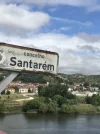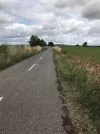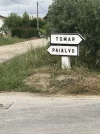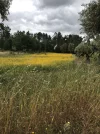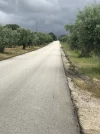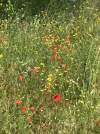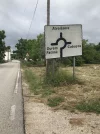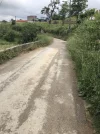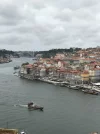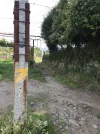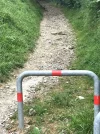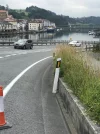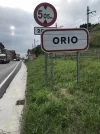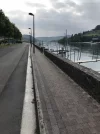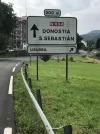michelle grech
Active Member
- Time of past OR future Camino
- Walked from Astorga to SDC in May 2012.
Cycled the Frances from SJPP May 2014
Cycled the Portuguese from Lisbon May 2016
Having just returned from cycling this Camino Portugues, I felt that I should share our experiences on this blog since I had found it quite difficult to find information which is specific to cyclists.
I must start by saying that this is a very beautiful and varied route. One cycles on all types of surfaces and through very different types of habitats. We stuck to the walkers' route most of the way and, I feel, some notes could help some cyclists who might prefer to take an alternative route around some of the rougher stints to avoid pushing the bike.
We cycled 707 kms in 12 days (according to mapmyride!) which is why I was a bit peeved when only 575 kms was written as the official distance on my compostela certificate! J Anyway, what’s in a number! We did the coastal route from Porto to Camiha, at which point we turned inland towards Valenca/Tui to rejoin the central route.
This was our itinerary.
DAY TO - FROM KMS
1 LISBON TO VILA FRANCA 44
2 VILLA FRANCA TO SANTAREM 54
3 SANTAREM - TOMAR 70
4 TOMAR - ANSIAO 54
5 ANSIAO - COIMBRA (via Chão de Couce) 63
6 COIMBRA - AGUEDA 55
7 AGUEDA - PORTO 85
8 PORTO - VIANA DO CASTELO 91
9 VIANA DO CASTELO - TUI 63
10 TUI - PONTEVEDRA 56
11 PONTEVEDRA - PADRON 42
12 PADRON - SDC 30
If you are flying in with your bike to Lisbon airport, the bike will emerge from carousel 13 and not the one marked for that flight. All odd-shaped luggage is routed through this belt so head straight there. Every carousel will direct you to no. 13 for the odd-shaped luggage. By chance, a bubbly attendant at the airport, who did not speak a word of English, instructed us to assemble the bikes by this carousel, and to leave the boxes there wasn’t a problem. Being able to just leave from here was great as this was our first potential headache. We decided to cycle from Lisbon airport to central Lisbon since it’s only about 8 kms and very manageable. We used Sygic, a navigator app on my iPhone to find the way, but we had done some homework of this route at home on google maps.
In Lisbon we stayed in a small B&B very close to the Se cathedral since we knew that this was the starting point of our journey and the place to buy a credencial if you don’t already have one. Do plan for an extra day or two to explore Lisbon. It is a beautiful city. We also stopped for an extra day in Porto as we felt we wanted to explore this city too, which was also a very good idea.
Way markings
I had read a lot of mixed opinions about the quality of the way-marking so I planned for the worst. I kept the Brierley guide at hand and bought the Camino Portugues app by Tania Gomes de Costa, which has one drawback…every morning you will have to download the map of the area you’ll be covering in the cache as it doesn’t have the feature to download the maps to your phone. I also downloaded the route maps from the Caminoways website onto the Ridewithgps app which, most of the time, seemed to veer away from the way-marked route. There is no way I was going to get lost!
The way-marking turned out to be better than I expected, all the way from Lisbon to Santiago. The arrows in Lisbon started out as small stickers on lamp posts but soon evolved into the normal freehand painted yellow arrow. You’ll soon get used to where to look for them. There were times we weren’t sure and had to stop to retrace our steps and now I realise that this was mainly because there are very few other pilgrims on the trail so you can’t just follow people dogmatically as you do on the Frances. But all in all I would say the marking is good. Having said that, I recommend having a back-up of some sort. I would also learn some basic Portuguese to ask directions as neither English nor Spanish is that widely spoken.
Bike Maintenance
Another thing to keep in mind is that we didn’t come across many bike shops, maybe since we were cycling through very small villages most of the time. Do be prepared to change a puncture and to do basic maintenance. I had to change my tyre and was directed to a lovely man, in the next town off the camino, who sold me a new tyre, switched tyres around and set the gears again all for Eur10! No common language between us, communication was very animated, but he did an excellent job and I was relieved to get my confidence in the bike back. It wouldn’t hurt to pack a spare tyre I guess although to be fair the damage on mine was not due to the camino even though parts of it are quite rough and it’s easy to cause some damage. The other thing is that mud is common (remember we cycled the camino last week of May, first week June); we power-washed and re-oiled the bikes when we got the chance.
The Route
As I said earlier, the terrain is very varied and there are some rough stints…and oh yes…those cobbled roman roads will not do your backside any favours. Maybe a gel seat would come in handy in the Portuguese part of this Camino. We jotted down these next notes only when we felt things were not so straight forward. We consider ourselves of average fitness, we love cycling and cycle most weekends. We definitely don’t describe ourselves as super-fit and we didn’t train that much, except for a few spinning classes in the run-up.
Day 3: Santarem to Tomar: We found some steep hills on rough terrain between Atalaia and Grou. You can opt to stay on the N10 especially if you’re tired by then.
Day 4: Tomar to Ansiao: The exit out of Tomar, along the river, is not recommended if it’s raining or has been raining. However, we found it beautiful, like being in the Amazon forest. Paths are narrow so wear full leggings to avoid scratches. Also, be careful at Ponte Ceras as you can easily stray into the woods and find yourself pushing the bike up a hellish trail, I would suggest to stay on the same road and skip that little bit of path between Ponte de Ceras and Portela de Vila Verde.
Day 5: Ansiao to Coimbra: Due to bike problems we had to cycle to Chau de Cause from Ansiao. We then took the road to make up for lost time and rejoined the trail at Zambujal. We can’t really comment on the trail between Ansiao and Zambujal!
Day 6 : Coimbra to Agueda: Leaving Coimbra, as in all cases of entering and leaving a big city, we do recommend riding on the pavement ie as if you were a walker, as the markings are for walkers and you might not be able to see them from the opposite side of the road. Pavements are usually wide and pedestrians are OK with it as long as you are courteous and always give them right of way.
Day 7 – Agueda to Porto: Path is fine up to Grijo. Then it turns into a lot of steep uphill roman roads
and, later from Peonzhino, muddy uphill trails. This was a long day and we were tired by this time. Could have done with finding an alternate route…but still it’s doable if you don’t mind pushing the bike. To cycle into Porto follow closely the walkers’ route, which means riding on pavements. Riding over the top of Pont Luis was a highlight.
Day 8 – Porto to Viana do Castelo: If at Esponsende you are tired, stick to the coast and don’t follow the yellow arrows inland as the trail gets a bit steep and rugged, beautiful though!
Day 9 – Viana do Castelo to Tui: The crossing over on the bridge from Valenca to Tui is just spectacular.
Day 10 – Tui to Pontededra: After Ponte Sampiano there is a steep and very rugged hill where you have no choice but to push the bike. If you don’t feel like pushing take the road to Figuerrido.
The other days not mentioned above were pretty straightforward for us.
Accommodation & Food.
From Lisbon to Porto we stayed mainly in small B&Bs. There are some cheap beautiful places, especially if you are sharing. Albergues are more common from Porto onwards and we stayed in them. There is more of a camino feel when you’re in Albergues somehow. We had decided not to carry a sleeping bag and I’m glad we didn’t as all places had blankets and clean bedding. We just used our silk liner every now and then.
Cafes are not that frequent on this route as they are on the Frances so do stop for your coffee and pastei de nata breaks when you get the chance, the next one available might be many kilometres ahead.
There is a good company in Santiago to pack your bikes at the end for a mere Eur21.... http://www.elvelocipedo.com/Velocipedo/Ingles/Velo_EmbalajeI.html. they did a fantastic job.
We prepared a 20 minute video of the journey which might give you a glimpse of what to expect.
Feel free to ask any questions, I will be happy to help where I can.
I must start by saying that this is a very beautiful and varied route. One cycles on all types of surfaces and through very different types of habitats. We stuck to the walkers' route most of the way and, I feel, some notes could help some cyclists who might prefer to take an alternative route around some of the rougher stints to avoid pushing the bike.
We cycled 707 kms in 12 days (according to mapmyride!) which is why I was a bit peeved when only 575 kms was written as the official distance on my compostela certificate! J Anyway, what’s in a number! We did the coastal route from Porto to Camiha, at which point we turned inland towards Valenca/Tui to rejoin the central route.
This was our itinerary.
DAY TO - FROM KMS
1 LISBON TO VILA FRANCA 44
2 VILLA FRANCA TO SANTAREM 54
3 SANTAREM - TOMAR 70
4 TOMAR - ANSIAO 54
5 ANSIAO - COIMBRA (via Chão de Couce) 63
6 COIMBRA - AGUEDA 55
7 AGUEDA - PORTO 85
8 PORTO - VIANA DO CASTELO 91
9 VIANA DO CASTELO - TUI 63
10 TUI - PONTEVEDRA 56
11 PONTEVEDRA - PADRON 42
12 PADRON - SDC 30
If you are flying in with your bike to Lisbon airport, the bike will emerge from carousel 13 and not the one marked for that flight. All odd-shaped luggage is routed through this belt so head straight there. Every carousel will direct you to no. 13 for the odd-shaped luggage. By chance, a bubbly attendant at the airport, who did not speak a word of English, instructed us to assemble the bikes by this carousel, and to leave the boxes there wasn’t a problem. Being able to just leave from here was great as this was our first potential headache. We decided to cycle from Lisbon airport to central Lisbon since it’s only about 8 kms and very manageable. We used Sygic, a navigator app on my iPhone to find the way, but we had done some homework of this route at home on google maps.
In Lisbon we stayed in a small B&B very close to the Se cathedral since we knew that this was the starting point of our journey and the place to buy a credencial if you don’t already have one. Do plan for an extra day or two to explore Lisbon. It is a beautiful city. We also stopped for an extra day in Porto as we felt we wanted to explore this city too, which was also a very good idea.
Way markings
I had read a lot of mixed opinions about the quality of the way-marking so I planned for the worst. I kept the Brierley guide at hand and bought the Camino Portugues app by Tania Gomes de Costa, which has one drawback…every morning you will have to download the map of the area you’ll be covering in the cache as it doesn’t have the feature to download the maps to your phone. I also downloaded the route maps from the Caminoways website onto the Ridewithgps app which, most of the time, seemed to veer away from the way-marked route. There is no way I was going to get lost!
The way-marking turned out to be better than I expected, all the way from Lisbon to Santiago. The arrows in Lisbon started out as small stickers on lamp posts but soon evolved into the normal freehand painted yellow arrow. You’ll soon get used to where to look for them. There were times we weren’t sure and had to stop to retrace our steps and now I realise that this was mainly because there are very few other pilgrims on the trail so you can’t just follow people dogmatically as you do on the Frances. But all in all I would say the marking is good. Having said that, I recommend having a back-up of some sort. I would also learn some basic Portuguese to ask directions as neither English nor Spanish is that widely spoken.
Bike Maintenance
Another thing to keep in mind is that we didn’t come across many bike shops, maybe since we were cycling through very small villages most of the time. Do be prepared to change a puncture and to do basic maintenance. I had to change my tyre and was directed to a lovely man, in the next town off the camino, who sold me a new tyre, switched tyres around and set the gears again all for Eur10! No common language between us, communication was very animated, but he did an excellent job and I was relieved to get my confidence in the bike back. It wouldn’t hurt to pack a spare tyre I guess although to be fair the damage on mine was not due to the camino even though parts of it are quite rough and it’s easy to cause some damage. The other thing is that mud is common (remember we cycled the camino last week of May, first week June); we power-washed and re-oiled the bikes when we got the chance.
The Route
As I said earlier, the terrain is very varied and there are some rough stints…and oh yes…those cobbled roman roads will not do your backside any favours. Maybe a gel seat would come in handy in the Portuguese part of this Camino. We jotted down these next notes only when we felt things were not so straight forward. We consider ourselves of average fitness, we love cycling and cycle most weekends. We definitely don’t describe ourselves as super-fit and we didn’t train that much, except for a few spinning classes in the run-up.
Day 3: Santarem to Tomar: We found some steep hills on rough terrain between Atalaia and Grou. You can opt to stay on the N10 especially if you’re tired by then.
Day 4: Tomar to Ansiao: The exit out of Tomar, along the river, is not recommended if it’s raining or has been raining. However, we found it beautiful, like being in the Amazon forest. Paths are narrow so wear full leggings to avoid scratches. Also, be careful at Ponte Ceras as you can easily stray into the woods and find yourself pushing the bike up a hellish trail, I would suggest to stay on the same road and skip that little bit of path between Ponte de Ceras and Portela de Vila Verde.
Day 5: Ansiao to Coimbra: Due to bike problems we had to cycle to Chau de Cause from Ansiao. We then took the road to make up for lost time and rejoined the trail at Zambujal. We can’t really comment on the trail between Ansiao and Zambujal!
Day 6 : Coimbra to Agueda: Leaving Coimbra, as in all cases of entering and leaving a big city, we do recommend riding on the pavement ie as if you were a walker, as the markings are for walkers and you might not be able to see them from the opposite side of the road. Pavements are usually wide and pedestrians are OK with it as long as you are courteous and always give them right of way.
Day 7 – Agueda to Porto: Path is fine up to Grijo. Then it turns into a lot of steep uphill roman roads
and, later from Peonzhino, muddy uphill trails. This was a long day and we were tired by this time. Could have done with finding an alternate route…but still it’s doable if you don’t mind pushing the bike. To cycle into Porto follow closely the walkers’ route, which means riding on pavements. Riding over the top of Pont Luis was a highlight.
Day 8 – Porto to Viana do Castelo: If at Esponsende you are tired, stick to the coast and don’t follow the yellow arrows inland as the trail gets a bit steep and rugged, beautiful though!
Day 9 – Viana do Castelo to Tui: The crossing over on the bridge from Valenca to Tui is just spectacular.
Day 10 – Tui to Pontededra: After Ponte Sampiano there is a steep and very rugged hill where you have no choice but to push the bike. If you don’t feel like pushing take the road to Figuerrido.
The other days not mentioned above were pretty straightforward for us.
Accommodation & Food.
From Lisbon to Porto we stayed mainly in small B&Bs. There are some cheap beautiful places, especially if you are sharing. Albergues are more common from Porto onwards and we stayed in them. There is more of a camino feel when you’re in Albergues somehow. We had decided not to carry a sleeping bag and I’m glad we didn’t as all places had blankets and clean bedding. We just used our silk liner every now and then.
Cafes are not that frequent on this route as they are on the Frances so do stop for your coffee and pastei de nata breaks when you get the chance, the next one available might be many kilometres ahead.
There is a good company in Santiago to pack your bikes at the end for a mere Eur21.... http://www.elvelocipedo.com/Velocipedo/Ingles/Velo_EmbalajeI.html. they did a fantastic job.
We prepared a 20 minute video of the journey which might give you a glimpse of what to expect.
Feel free to ask any questions, I will be happy to help where I can.
Last edited:











